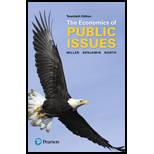
Whether it is possible for laws restricting dangerous or destructive activity to be too strict.
Explanation of Solution
It is not possible to enact laws that completely restrict dangerous or destructive activity as enacting these laws will involve restricting activities to such a degree that the economic costs associated with such laws will prove to be too high.
There is always a trade-off involved in taking any economic decision, and it arises due to the scarcity of resources. This scarcity results in an
Thus, until the point where the marginal benefits of additional level of reduction in dangerous or destructive activities equals the marginal costs of reducing the additional level of dangerous or destructive activities, the efforts to reduce the same must be continued.
Concept introduction:
Opportunity cost:
If one alternative is chosen over another alternative, then there is a cost involved in choosing the respective alternative i.e. the cost of the foregone alternative. This forgone cost is known as the opportunity cost.
Marginal
An increased cost to society by any activity of an individual or a firm is known as marginal social cost. It is calculated by adding the marginal external cost to the marginal private cost.
Marginal social benefit:
An increased benefit to the society by any activity of an individual or a firm is known as marginal social benefit. It is calculated by adding the marginal external benefit to the marginal private benefit.
Want to see more full solutions like this?
Chapter 6 Solutions
Economics of Public Issues (20th Edition) (The Pearson Series in Economics)

 Principles of Economics (12th Edition)EconomicsISBN:9780134078779Author:Karl E. Case, Ray C. Fair, Sharon E. OsterPublisher:PEARSON
Principles of Economics (12th Edition)EconomicsISBN:9780134078779Author:Karl E. Case, Ray C. Fair, Sharon E. OsterPublisher:PEARSON Engineering Economy (17th Edition)EconomicsISBN:9780134870069Author:William G. Sullivan, Elin M. Wicks, C. Patrick KoellingPublisher:PEARSON
Engineering Economy (17th Edition)EconomicsISBN:9780134870069Author:William G. Sullivan, Elin M. Wicks, C. Patrick KoellingPublisher:PEARSON Principles of Economics (MindTap Course List)EconomicsISBN:9781305585126Author:N. Gregory MankiwPublisher:Cengage Learning
Principles of Economics (MindTap Course List)EconomicsISBN:9781305585126Author:N. Gregory MankiwPublisher:Cengage Learning Managerial Economics: A Problem Solving ApproachEconomicsISBN:9781337106665Author:Luke M. Froeb, Brian T. McCann, Michael R. Ward, Mike ShorPublisher:Cengage Learning
Managerial Economics: A Problem Solving ApproachEconomicsISBN:9781337106665Author:Luke M. Froeb, Brian T. McCann, Michael R. Ward, Mike ShorPublisher:Cengage Learning Managerial Economics & Business Strategy (Mcgraw-...EconomicsISBN:9781259290619Author:Michael Baye, Jeff PrincePublisher:McGraw-Hill Education
Managerial Economics & Business Strategy (Mcgraw-...EconomicsISBN:9781259290619Author:Michael Baye, Jeff PrincePublisher:McGraw-Hill Education





